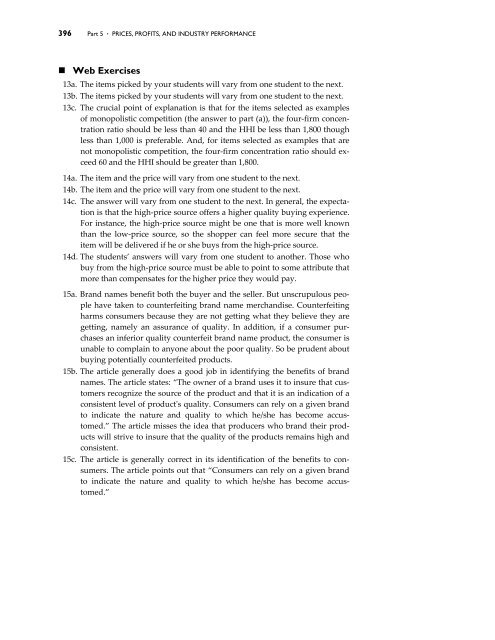Monopolistic Competition
Monopolistic Competition
Monopolistic Competition
Create successful ePaper yourself
Turn your PDF publications into a flip-book with our unique Google optimized e-Paper software.
396 Part 5 . PRICES, PROFITS, AND INDUSTRY PERFORMANCE• Web Exercises13a. The items picked by your students will vary from one student to the next.13b. The items picked by your students will vary from one student to the next.13c. The crucial point of explanation is that for the items selected as examplesof monopolistic competition (the answer to part (a)), the four‐firm concentrationratio should be less than 40 and the HHI be less than 1,800 thoughless than 1,000 is preferable. And, for items selected as examples that arenot monopolistic competition, the four‐firm concentration ratio should exceed60 and the HHI should be greater than 1,800.14a. The item and the price will vary from one student to the next.14b. The item and the price will vary from one student to the next.14c. The answer will vary from one student to the next. In general, the expectationis that the high‐price source offers a higher quality buying experience.For instance, the high‐price source might be one that is more well knownthan the low‐price source, so the shopper can feel more secure that theitem will be delivered if he or she buys from the high‐price source.14d. The students’ answers will vary from one student to another. Those whobuy from the high‐price source must be able to point to some attribute thatmore than compensates for the higher price they would pay.15a. Brand names benefit both the buyer and the seller. But unscrupulous peoplehave taken to counterfeiting brand name merchandise. Counterfeitingharms consumers because they are not getting what they believe they aregetting, namely an assurance of quality. In addition, if a consumer purchasesan inferior quality counterfeit brand name product, the consumer isunable to complain to anyone about the poor quality. So be prudent aboutbuying potentially counterfeited products.15b. The article generally does a good job in identifying the benefits of brandnames. The article states: “The owner of a brand uses it to insure that customersrecognize the source of the product and that it is an indication of aconsistent level of productʹs quality. Consumers can rely on a given brandto indicate the nature and quality to which he/she has become accustomed.”The article misses the idea that producers who brand their productswill strive to insure that the quality of the products remains high andconsistent.15c. The article is generally correct in its identification of the benefits to consumers.The article points out that “Consumers can rely on a given brandto indicate the nature and quality to which he/she has become accustomed.”



